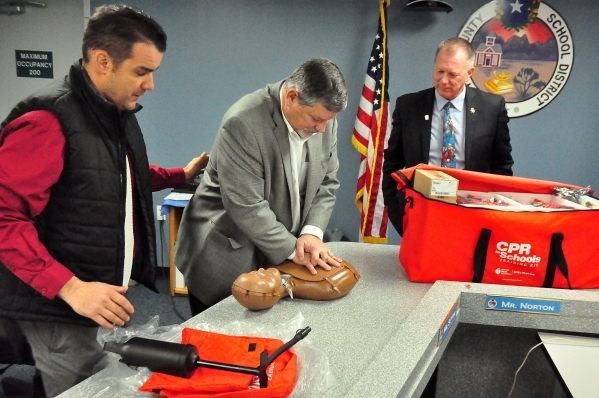
Nye County School District students are learning a most important lesson beyond their regular curriculum that may save someone’s life one day.
This month, the district received CPR kits which will be used by teachers to properly teach the district’s estimated 6,000 students lifesaving skills.
District Superintendent Dale Norton noted the value of having the kits in schools around the state’s largest district by size.
“I’m excited up about that because we can take the second kit and use it throughout our rural communities like Gabbs, Tonopah and Round Mountain, as well as Beatty and Amargosa,” he said. “I think that our middle school-level kids are very capable of doing this also. We will have plenty of resources available for them. If it saves one life, it’s all the more worth it.”
Each kit includes a facilitator guide, lesson plan, and a detailed how-to DVD, along with 10 inflatable CPR mannequins, during what is described as a 30-minute interactive, hands-on session.
State Assemblyman James Oscarson said the process of acquiring the kits came during the 2013 legislative session.
“They will be able to be used throughout the district to teach this important process,” he said. “They were able to get these kits for the rural schools, which are most important. Our response time is so much different than it is in urban areas so these will be used to sustain and save lives.”
Ben Schmauss of the American Heart Association presented the kits at the Nye County School District office on Thursday.
He too noted emergency response times in rural areas can be much longer than those in more populated cities.
“When someone suffers a heart attack, they have approximately seven minutes worth of oxygen in their blood,” he said. “In Vegas, help can come within four to six minutes, so this could literally be the difference between someone being brain dead, and someone actually having full function again because we’re circulating that body.”
Schmauss also said teachers do not have to be CPR-trained to teach the procedure to middle and high school students.
“The DVD literally walks you through everything,” he said. “They have to physically perform compression on the chest. We want the kids to physically practice this because when mom or dad or a sibling goes down, they can physically perform CPR. The kit contains wipes and 10 DVD’s, but the teacher only needs one. The whole kit is plug and play. We actually got just one initially, but we were able to get a second one by a silent donor.”
According to the American Heart Association, more than 326,000 people experience sudden cardiac arrest each year, which is the leading cause of death in the country.
Statistics show that immediate, effective CPR can double or triple a victim’s chance of survival, but only 32 percent of cardiac arrest victims get CPR from a bystander, while less than 8 percent of victims survive, due to lack of CPR and Automated External Defibrillators used across the country.
Schmauss said middle and high school students in Clark County are now receiving the CPR training, which has already made a difference.
“We have gotten reports back that two children have saved lives in Clark County,” he said. “One child saved her little sister and a stepfather of another child was laying tile at home when he fell over. She was able to have someone call 911 and apply CPR at the same time.”
Additionally, Schmauss said there have been recent changes to how CPR chest compression are applied to victims.
“When I was growing up, we did CPR with compression and breaths, because ultimately, that’s a higher quality of resuscitation,” he said. “We knew one of the major barriers was people didn’t want to put their mouth on someone else. When we can have a child or at adult providing these compression and giving that extra time for the brain and vital organs to receive oxygen, that saves lives.”
Schmauss also spoke about the correct amount of chest compression the patient should receive.
He alluded to a popular 1970’s disco hit by the Bee Gees.
“The 70’s disco song ‘Staying Alive,’ by the Bee Gees is such an easy way to remember,” he said. “Almost all of us know that Bee Gees song and if you’ve never performed compressions and need to remember the actual rate of compressions to the chest, it’s 100 beats per minute. That ‘Staying Alive’ rhythm is easy for us to get going in our head to remember as we are applying the compression.”
Oscarson, meanwhile, said he is looking to build on the partnership established between the school district and the American Heart Association.
“I am especially proud of the relationship we are continuing to establish with the school district and the American Heart Association. This isn’t the end of it, this is just the beginning of what’s already been a great relationship and we’re sustaining that relationship.”
Contact reporter Selwyn Harris at sharris@pvtimes.com